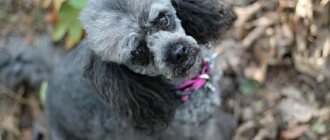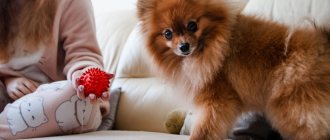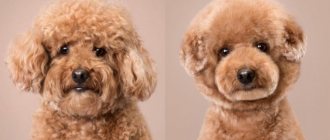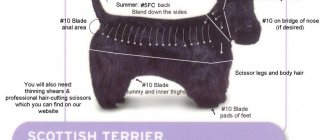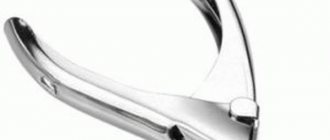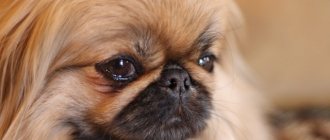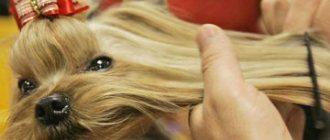Required age for the first procedure
Some owners are sure that the puppy should not be cut. This opinion is fundamentally wrong. A simple hairstyle will not harm the puppy's fur, but will instead create an addiction in the dog. Grooming should be carried out from 3-4 months. If you start the procedure at a young age, the dog will not become nervous in the future.
The puppy experiences its first molt between the ages of 3 and 8 months. Up to 3 months, the dog is simply combed thoroughly without bathing or grooming.
But a model haircut for a puppy is unacceptable. The coat at a young age is not sufficiently formed. A complex hairstyle for a pet can only be done from 11-12 months. Before this, you should remove some hair from the ears, paws, and slightly shorten the hair under the tail. Otherwise, the baby will look sloppy.
Features of Spitz dogs
Spitz are short dogs with a plush coat and a luxurious “lion’s mane” that turns the pet into a teddy bear. Volume is provided by a thick undercoat with coarse hair growing perpendicular to the skin.
The breed has arctic-type wool: it regulates air exchange near the skin, protects from cold in winter and from overheating in summer. Its condition depends on vitamins in the diet, properly selected shampoos, walking conditions and regular grooming of the Spitz. Without proper care, tangles quickly form, and guard hair begins to fall out with the formation of bald areas. The most problematic areas: the crotch, armpits between the legs, ears.
The fine down begins to give way to mature, coarse hair at 4 months after the first molt. The peak of fall is observed in spring and autumn during the off-season. Complete replacement with the appearance of the final shade ends by 3 years.
Thanks to the unique structure of the coat, the process of molting in a Spitz is almost invisible to its owners. The sparse guard hairs remain in the thick layer of fur after falling out and therefore require careful combing. Their shortening and neat edging make them easier to care for.
Possible hairstyle options for your pet
The most common hairstyles are a hygienic haircut and an exhibition one. The first step is to maintain a well-groomed appearance of the dog. The fur is shortened under the tail, on the paws, and possibly shortened on the ears. Only those parts that interfere with keeping the dog clean are cut.
A “classic” haircut is called an exhibition haircut. The main goal of this hairstyle is to make the dog as attractive as possible, hiding flaws. The ears barely peek out from the fluffy coat, the paws and tail are rounded. A rounded “collar” is created around the neck.
When to start skincare procedures?
There are those who are sure that a Spitz should not be cut during puppyhood. However, it is necessary to start cutting and combing your Pomeranian puppy from an early age, so that in the future the animal will respond normally to procedures.
At about 3-4 months, this is easy to do, since the fur is still very soft, more like fluff.
After a year, it becomes much tougher, and the dog has a thick undercoat. At the same time, the first haircuts should be as simple as possible, otherwise the puppy will develop a dislike for the long and tedious event.
Types of Pomeranian haircuts
All of them can be classified according to certain characteristics and purpose. So, four types of haircuts are formed:
- very short;
- short;
- exhibition;
- classic.
Spitz haircut photo
Very short haircuts (“BU”, “Bear”)
The Pomeranian Spitz, cut like a bear, became popular after photographs and videos of a representative of this breed, nicknamed Boo, were published on the Internet. For a long time, the fashion for this haircut has been maintained to this day.
Its peculiarities are very short hair, evenly trimmed throughout the body. In this case, the head area is processed in such a way that it acquires a spherical shape.
Photo of a spitz haircut to look like a teddy bear
The procedure for cutting the hair like a teddy bear is carried out with slight modifications - the differences concern some exterior details. In both cases, you should consult your veterinarian and groomer to see if your Pomeranian can have these types of haircuts. The fact is that a very shortened undercoat and guard hair can disrupt thermoregulation and skin protection. In addition, these haircut patterns for Spitz dogs can cause baldness. The undercoat is not restored after cutting, and short haircuts subsequently lead to the fact that the coat consists of only guard hairs.
Spitz haircut like a bear
Short haircuts (“like a fox cub”, “like a lion cub”)
The image of a decorative lion cub is one of the most charming and popular. To achieve this, the dog's body is cut short to the level of the back edge of the shoulder blades. In front, the head and withers area remain slightly trimmed. The front legs are also left with fur. At the same time, the hindquarters are shaved almost completely down to the level of the hocks. A small tassel of wool is left at the very tip of the tail.
No less attractive is the “fox-like” haircut. The length of the coat remains at 3-4 cm, this length is uniform throughout the dog’s body.
Classic haircut
This option is more suitable for everyday walks. The coat is cut to a length of approximately 5-6 cm, while it is advisable not to touch the undercoat.
The shapes are also standard - rounded, with smooth configurations in the area of the head, paws and scruff. You can even do this haircut yourself, if you have the necessary tools and an assistant - one of the family members.
As a result, the pet becomes almost round in shape and resembles a plush toy.
Exhibition haircut
Characteristic features of a Spitz trimmed in a show style are:
- rounded paw shapes;
- absence of protruding hairs throughout the body;
- the gate area is round in shape.
The basis for an exhibition haircut is hygienic. Usually carried out simultaneously with nail trimming, eye treatment and ear cleaning. Helps maintain the health of the dog's coat and appearance.
When do you need a haircut?
The majority of modern owners, following fashion trends, believe that a well-done haircut gives the pet nobility. Of course, a neat and well-groomed dog looks much neater and more attractive and is the real pride of the owner. At the same time, the prices for grooming a Spitz are quite high.
After the haircut
When is it still worth cutting the Pomeranian Spitz and other representatives of the class:
- Untrimmed fur rolls up strongly and tangles form. It is quite difficult to comb them out and you have to cut them off.
- Ungroomed thick fur is a suitable habitat for various viruses, pathogenic bacteria and fungi. In addition to becoming infected itself, the dog will bring the infection home.
- Among other things, fleas, ticks and lice eaters get along well in thick fur. It is quite difficult to clean an overgrown animal of parasites. It is much easier to rid a neatly trimmed dog of pests with the help of special disinfectants.
- To prevent decreased hearing and visual acuity, trim thick hairs in these areas. Hairs constantly get into the eyes and ears, which provokes irritation, itching, redness and even the formation of purulent discharge.
If you plan to have your pet participate in exhibition events, take care in advance about the correct haircut, go to a salon or call a professional for a haircut at home. Judges at exhibitions pay attention not only to the purity of the breed, but also to the exterior of the animal, including grooming and quality of hairstyle.
Pomeranian
A Pomeranian trimmed according to standards looks well-groomed and respectable. But in recent years, the fashion trend is the “bear cub” hairstyle. Pets cut this way really resemble teddy bears.
You should start grooming babies after the first shedding; this will allow them to get used to the hygiene procedure and no problems will arise.
How to cut your hair at home?
Stages of work:
- Before you start grooming, the dog is thoroughly combed.
- The procedure begins with the paws. First, the pads and fingers, as well as the space between them, are treated. This is done using thin scissors, and tangles and clogged dirt are removed. To create the effect of a cat's paw, the fur is cut around the circumference of the paw.
- After the paws are trimmed, they begin to process the “pants” using a machine. The haircut is done from top to bottom, along the hair growth line.
- The base of the tail is trimmed with scissors in the direction of hair growth. After which the anus and genital area are treated.
- The belly is carefully processed with a machine, leaving at least 3 cm of fur length.
- Tail processing. The tail itself should be cut very carefully so as not to spoil its appearance. If you do not have experience in grooming, then simply trim the hair on the tail with scissors.
- The next stage is processing the ears. They are trimmed especially carefully so as not to injure the pet’s delicate skin. First, the overgrown hairs at the tips are cut off, and then the ears are given a rounded shape. After this, the regrown hairs on the inside of the ear are pulled out with special tweezers. Treating Spitz ears is a very delicate procedure and requires special skills.
- The area of the back and sides is trimmed first with regular and then with thinning scissors. In this case, the movements should follow the outlines of the dog’s silhouette.
- If the hair is on the withers and sides of the branch, they are carefully cut with scissors.
- The area of the back of the back is treated especially carefully so that the hair does not prevent the tail from curling freely.
Haircut options
Hygienic
If you don’t know how to properly trim your Spitz yourself, you don’t have to immediately go to a dog salon, because the cost in Moscow and other cities is quite high. After watching the instructional videos, you can do it yourself at home.
Before you begin the procedure, thoroughly comb out the undercoat and remove matted tangles and tufts.
You need to trim your Spitz as follows:
- To make the ears round, carefully remove the lint sticking out at the tips.
- Remove long hairs around the circumference of the paws.
- Remove any hair that sticks out from your ears.
- Trim the fur from the back of the panties and near the anus.
- Using thinning scissors, carefully go around the root of the tail so that it bends and reaches the withers.
Hygienic haircut
Traditional
A traditional haircut involves slightly shortening the fur throughout the pet’s body to give it a beautiful and well-groomed appearance.
Check out the different types of Spitz.
Before you begin the procedure, complete the following steps:
- Wash your baby with a special shampoo for long-haired dogs and use conditioner.
- Wrap it in a towel and let the moisture absorb.
- Dry the coat completely with a hairdryer using a moisturizing and nourishing spray.
- Brush your pet with a fine-toothed comb, starting from the roots of the hair to the very ends.
Prepare scissors with safety rounded ends for cutting the main coat and thinning scissors for thinning.
At the groomer's
The procedure is as follows:
- When combing your dog with a fine-toothed comb, carefully cut off any hairs that stick out after brushing. Don't touch the rest.
- Start with the head and collar area.
- Then carefully remove the fur from around the ears. Try to do everything with one movement of the scissors. Trim the ears only from the top, without touching the sides.
- Leave it on the collar.
- After this, process the “pants”.
- Trim the tail so that it does not look cropped.
Traditional hairstyle
Exhibition
Dogs that look natural are allowed for exhibitions, so don’t get carried away with the haircut; it should hide flaws and highlight your pet’s strengths.
You can trim the undercoat slightly, removing only the stray hairs. After the procedure, carefully profile the dog’s silhouette and give the collar area a rounded shape.
During this procedure, adhere to exhibition standards, by which the pet’s exterior will be assessed:
- the dog should look round;
- the ears should not stick out, but should softly merge with the contour of the head;
- no loose fibers should be visible on the pet’s body;
- fingers are cut in the shape of a “cat’s paw”;
- the tail is fanned out on the back, and its end reaches the head.
Exhibition version
Dog grooming scissors: what are they?
- With adjusting screw. These dog grooming scissors are very comfortable; you can adjust their properties depending on the animal’s coat. Be careful, if you overtighten the screw, there will be a strong load on your fingers and the wool may be “bitten.” The length of the tool is veiled from 4.5 to 8.5 inches. (11.5-22 cm.) Short, often chosen for small amounts of work. More than 20 cm, where no great effort is required. Their cost is 1800-3500 rubles.
- Direct. Such a tool can also be of different lengths. Short ones are chosen for small dogs, with rounded tips for cutting in the ears, between the pads of the paws, and on the muzzle. Long ones are great for long work. It is more comfortable to use scissors whose rings are not at the same level, thanks to this there is less stress on the fingers. Also, a micro-notch is made on the blade of the tool - it prevents the hair from slipping away. Price from 2000 to 6500 rubles.
- Curved. These are straight scissors that bend slightly towards the end. They are used to trim the tail, muzzle, and shape the ears. Cost 800-2800 rub.
Thinning scissors for cutting dogs (grooming). This is a very popular tool among groomers. There are different varieties, they differ only in the number and number of teeth, they come on one side or on both. These teeth allow you to carefully grab each hair and make a smooth cut; they make a smooth transition, soft steps, thin out thick fur, or, on the contrary, add volume. Scissors with one-sided teeth allow you to cut more than double-sided ones, some find it rougher, but a master should be able to use any tools, but for beginners, it’s better to learn to use double-sided ones. The average size of such a tool is 14-15 cm. The thicker the wool, the wider the spacing of the teeth should be. Price 2500-11000 rub.
Prices for Spitz haircuts:
| Breed | Wash dry | Short haircut | Grooming long hair | Tangles (RUB/hour) | Complex |
| Spitz medium (Japanese) | 2500 rub. | 1600 rub. | 1600 rub. | 300-600 rub. | 3500-4000 rub. |
| Pomeranian Spitz (up to 23 cm) | 2000 rub. | 1500 rub. | 1500 rub. | 300-600 rub. | 2600 -3200 rub. |
| Small German Spitz (23-28 cm) | 2500 rub. | 1500 rub. | 1500 rub. | 300-600 rub. | 3000 -3600 rub. |
| Spitz (keeshond) | 2700 rub. | 1700 rub. | 1700 rub. | 300-600 rub. | 3800-4600 rub. |
The structure of the coat
Up to 3 months, the puppy’s body is covered with thin hairs that resemble fluff. A dog’s full-fledged, “adult” coat begins to form at 3.5 months and finally changes by the age of one year. The Spitz coat consists of 2 parts:
1. Guard hair – hard and straight hair. It stands perpendicular to the dog's body.
2. Undercoat - soft, long spiral hairs. Makes up the bulk of wool.
The Pomeranian's thickest hair is located on the collar, tail and hind legs.
When does an orange shed?
The coat of a Miniature Spitz (Pomeranian) is replaced regularly throughout its life. There are several types of shedding:
- Children's - from four months the guard hair and undercoat begin to fall out - first from the muzzle, then from the body, paws and “panties”.
- Junior - from one to two years of age, the fluff is replaced with real undercoat and hard hair.
- Seasonal - annual spring molting is caused by the active production of melatonin and lasts 2-3 weeks.
- Hormonal – associated with estrus in bitches, most often in the spring, after childbirth.
What to do if after cutting the hair begins to grow poorly?
The problem of short hair in the breed always puzzles Pomeranian owners. If you cut the undercoat too short, it is almost impossible to restore it later - only the guard hairs grow. The owner of the animal can use methods and means recommended by veterinarians. As a rule, these are hygienic cosmetics, lotions, sprays, special shampoos with vitamin supplements for hair growth.
Photo of a Pomeranian Spitz
To combat the problem of baldness and poor hair growth, the following set of actions on the part of the owner is recommended:
- organization of proper, balanced nutrition, which will increase the content of vitamins D, E, calcium and sulfur components;
- frequent long walks - some substances necessary for hair growth are produced in the body only in the presence of sunlight;
- checking for the presence of lice and fleas, and if they are found, sanitary treatment;
- Drinking plenty of water is necessary for intensive water exchange, which ensures the transport of beneficial components to the fur cells.
If these efforts do not bring results, you should contact your veterinarian for advice and prescribe a therapeutic course.
Photo of a trimmed Spitz
How to cut your own hair
If you have the necessary skills and tools, you can trim your Pom yourself for free. To do this, you can familiarize yourself with the instructional step-by-step video and examples of techniques in the photo.
Find out what a sable Spitz looks like.
Required Tools
Before the procedure, prepare the following tools:
- slicker;
- a comb with long metal teeth;
- straight scissors with good running;
- shampoo for long-haired dogs;
- hair dryer for drying animals and towels;
- table with a non-slip surface.
Tools
It would be ideal to add to this set a machine with a 0.25 mm blade, curved and thinning scissors.
Preparation
Before you start cutting your animal, you need to comb it properly.
Pomeranians need regular brushing 1-2 times a week. This cannot be done every day so as not to remove the bulk of the undercoat.
To prevent your baby from experiencing discomfort during combing, accustom him to the procedure from the first days of his life in the family. Here's how to do it step by step:
Combing
- For the first time, it is allowed to sit the pet on your lap so as not to immediately injure the psyche. Over time, when he gets used to your actions, he will be able to stand still.
- Use a soft massage brush. She doesn't pull hair out of the fur. The direction of combing should be against the grain.
- Due to its structure, the fur practically does not get tangled. The exceptions are the armpits, fingers and groin area. Exactly where the fur is softest. Before trimming your Pomeranian's butt, paws and armpits, you need to fluff them up by hand and then comb out the dead hairs.
- To prevent the fur from becoming electrified, use antistatic agents. To moisturize, use special sprays and conditioners.
- After the dog has been combed, you need to buy it, then dry it with a towel and dry it completely with a hairdryer.
Preparation for the procedure
The pet should not be afraid of such a procedure, because he will have to undergo it several times throughout his life. Therefore, the very first trip to the grooming salon should end with the dog’s most positive emotions. After a haircut, the Pomeranian should remain calm and cheerful. This largely depends on the preliminary preparation of the animal by the owner:
- The first thing you need to do is to accustom your pet to bathing;
- The second condition: the dog must react positively to the master himself and his office. For this purpose, it is better to visit the groomer in advance (perhaps even a couple of times). It’s good if the animal receives a small treat from the owner in the salon - this will build trust in the new environment and avoid internal tension;
- The third point of preparation is getting used to the noise of the hair dryer and tools, which should not cause any negative emotions or anxiety in the dog.
Be sure to give the dog a bath and comb its fur on the day of the procedure or the day before - after bathing, the hair is cut much easier.
Photo of a shorn spitz
Rules for caring for Spitz hair
When carrying out grooming, it is important to take into account the characteristics of your pet’s coat:
- Spiral-shaped guard hairs lift the coat, so voluminous “air” haircuts are preferred.
- Every day you need to thoroughly comb your dog with a soft brush, paying special attention to the neck, groin area and belly of the animal. It is necessary to use special conditioners that reduce the number of tangles.
- The dog should be bathed no more than once a month at a water temperature of 34-36°C, be sure to dry it with a hairdryer using a stream of cool air, and comb it with a slicker brush.
- Use only high-quality and certified feed: the quality of wool depends 60% on the received nutrients, mineral compounds and vitamins.
During the first months, it is better to choose a simple hygienic haircut. Gradually, the dog gets used to grooming and reacts calmly to nail trimming. If necessary, young Spitz dogs undergo express molting.
First haircut
Now let’s figure out at what age a Pomeranian can be cut. Up to 3 months, the puppy should only be combed, not forgetting to monitor the condition of the eyes and ears. Bathing your baby unnecessarily is also not worth it, because he is sensitive to chemicals.
From 3 to 8 months, a Pomeranian puppy experiences its first molt. During this period, the undercoat actively falls out. The baby looks sloppy and tattered.
To improve its appearance, during this period you can cut off the ends of the guard hair, as well as shape the ears and remove excess on the paws.
Once every 3 days, the puppy should be combed using a slicker brush. Also, during molting, the risk of matting increases, which must be cut off.
Important! Model haircuts can be done for a puppy who is 11-12 months old. At this point, his coat is completely formed.
At what age should I start?
At the beginning of life, a Spitz puppy has fluff and only after reaching three months does wool with a thick undercoat appear. For this reason, it is recommended to start grooming your Spitz in the fourth month of life.
Is it possible up to a year?
Before the grooming procedure, it is necessary that the puppy has received all vaccinations, and also, by this time, he must have already experienced his first molt.
By three months, the puppy is already able to accept the procedure relatively calmly, which allows him to avoid skin injuries or uneven haircuts that could occur if the Spitz was trimmed at a more tender age.
Which dog is suitable for "Little Fox"
The most important rule is to cut “fox-like” better than fox-type oranges. These minis make excellent fox cubs. Some breeders ask groomers to make a fox cub from a Bear Spitz, but usually the result is not very good. The dog becomes cuddly and bears little resemblance to a red fox.
Bear or fox
Grooming experts argue that the shape of the muzzle and the quality of the fur are different among the subspecies. In this form, it is quite easy to distinguish a dog from a fox.
At the same time, regardless of the result, you will pay a rather high price, but you will not achieve the desired result. A haircut can cost from 1.5 thousand rubles.
Why do Pomeranians get their hair cut?
Owners of Pomeranian dogs prefer to trim their pet's fur because it is easier to care for after trimming.
The orange's long coat gets dirty easily, making it difficult to care for. Long hair can get stuck in various debris and dust. Some Pomeranian owners prefer the appearance of shorter hair on their pet. Pomeranian owners cut their pets' hair especially short in the summer to keep them cooler, although this is not entirely true. If you live with a dog in a cold climate, then long hair may be appropriate only for keeping warm. Meanwhile, this beautiful luxurious fur will need constant care, and if you don’t take care of it, you will inevitably encounter tangles and fur in your home.
To avoid unnecessary hassle, your Pomeranian should be trimmed and well-groomed.
We serve all areas
We serve all areas of the city of Rostov-on-Don. We go to the house.
- Grooming a German Spitz video tutorial Kaluzhskaya Street
- Grooming a German Spitz video tutorial Dumsky Proezd Lane
- Grooming a German Spitz video tutorial Good Street
- Grooming a German Spitz video tutorial Glacier 2nd Street
- Grooming a German Spitz video tutorial Leskhoz street
- Grooming a German Spitz video tutorial Kombaynovskaya 2nd Street
- Grooming a German Spitz video tutorial Barnaul Lane
- Grooming a German Spitz video tutorial Skifskaya Street
- Grooming a German Spitz video tutorial Growing Street
- Grooming a German Spitz video tutorial Magazine Street
- Grooming a German Spitz video tutorial Myagky Lane
- Grooming a German Spitz video lesson 27 Line street
- Grooming a German Spitz video tutorial Kupecheskaya Street
- Grooming a German Spitz video tutorial Raevsky street
- Grooming a German Spitz video tutorial Western Quarry Lane
- Grooming a German Spitz video tutorial Brave Street
- Grooming a German Spitz video tutorial Kabardinskaya street
- Grooming a German Spitz video tutorial Oganova Street
- Grooming a German Spitz video tutorial Terminal Street
- Grooming a German Spitz video tutorial Goncharova Street
Choosing a Groomer
As for the choice of grooming specialists, today it is great. Almost every city has at least one master. Each person has their own price for the service. It depends on the experience of the master, on the place of his work, on the tools and means he uses. For example, a professional haircut at home may cost less than in a salon, but this does not mean that it is worse. Be sure to read reviews and look at photos of the work, so that later you don’t have to regret the money spent and the spoiled appearance of your Spitz.
Many dog owners love not only to cut their hair, but also to decorate their pets. Rhinestones are glued to the tips of the ears and sparkles are applied. It is harmless to the dog and looks beautiful, but does not last long. When contacting the salon, you can choose the designs that are most attractive to you or ask the master to create a pattern based on your own design.
Treatment of consequences
Why doesn't wool grow?
Many owners of this beautiful decorative dog breed notice that over time, after constant short haircuts, spots appear on its skin, as if it is going bald. And such doubts are indeed justified. Alopecia or baldness can be caused by several factors:
- allergy;
- effects of toxic or irritating substances;
- parasites or fleas;
- hormonal imbalance.
It is very easy to see the manifestations of this disease; the animal’s hair begins to fall out. This may happen suddenly or gradually. Baldness can be accompanied by unpleasant itching.
Reference! Alopecia in dogs is not an independent disease; there is always a reason for its appearance.
How to recover?
If you are sure that the dog does not suffer from any diseases that could cause hair loss, then this is mechanical alopecia. Baldness is always treated based on the reasons that cause it.
The veterinarian selects a course of medications. In the case of mechanical alopecia, the owner of the affected dog will only have to wait:
- give up short haircuts;
- give the dog time.
She will need six months at best. If the case is extremely severe, it will take up to two years to grow new hair.
Basic rules for cutting Spitz dogs
It is necessary to know the peculiarities of the structure and renewal of hair in order to make an even edging and not disturb the nutrition of the roots, therefore it is not recommended to cut your pet’s hair at home. In the salon, the specialist uses high-quality tools, combs and slickers, disinfectant solutions, hypoallergenic products with antistatic action.
There is no need to cut your pet's hair yourself: if it is accidentally damaged or shaving is too short, the hair growth will not be restored. The consequence of unprofessional grooming of Spitz dogs is mechanical alopecia, long-term and expensive treatment. The master carefully checks the length and direction of the villi during work, so as not to disrupt the process of thermoregulation of the skin, not to provoke sunburn in the summer and frostbite in the cold.
At the ARTEMONoff salon in Moscow, Spitz haircut prices are quite affordable for all owners of these charming dogs. The cost is affected by the range of services chosen. We adhere to strict sanitary standards and requirements, which eliminates injury and infection during procedures. Masters do not use sedatives to calm pets, trying to find an approach to the most impatient four-legged clients.
